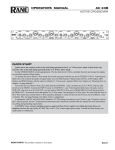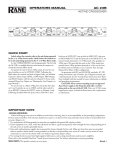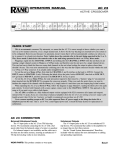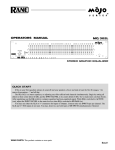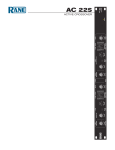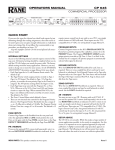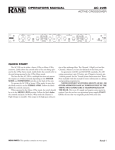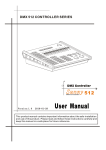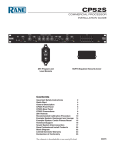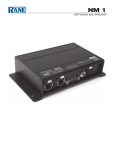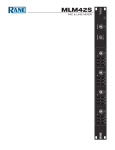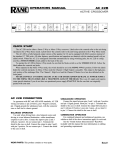Download Rane AC 23S Operating instructions
Transcript
OPERATORS MANUAL AC 23S ACTIVE CROSSOVER LOW CH 1 4 LEVEL 6 2 4 8 0 LOW / MID 2W: INACTIVE MASTER LEVEL 10 MONO MASTER 6 2 8 0 10 DELAY MUTE 4 6 2 8 MIN MAX SUBWOOFER MID 2W: INACTIVE 2W: LOW FREQUENCY LEVEL DELAY 240 400 MUTE 200 600 4 6 4 6 150 750 100 850 80 900 2 8 2 8 70 1k 0 SUB / LOW 10 MIN MID MID / HIGH 2W: LOW / HIGH FREQUENCY 700 1.0k 550 2.0k 475 2.8k 350 4.5k 250 5.8k 190 7.0k MAX HIGH CH 2 LEVEL MASTER LEVEL 4 2 4 8 0 4W: MID / HIGH 5W: MID / HIGH-MID 6 10 LOW 6 2 4 8 0 10 MONO 4W OR 5W: INACTIVE LOW / MID 2W: INACTIVE LEVEL 6 2 8 0 DELAY MUTE 4 2 10 8 MIN LOW 6 MID 2W: INACTIVE 2W: LOW FREQUENCY LEVEL DELAY 240 400 MUTE 200 600 4 6 4 6 150 750 100 850 80 900 2 8 2 8 70 1k MAX 0 LOW / MID 10 MIN 4W: INACTIVE 5W: HIGH-MID MID / HIGH 2W: LOW / HIGH FREQUENCY 700 1.0k 550 2.0k 475 2.8k 350 4.5k 250 5.8k 190 7.0k MAX HIGH LEVEL 4 AC 23S ACTIVE CROSSOVER 8 0 4W: INACTIVE 5W: HIGH-MID / HIGH 6 2 10 HIGH POWER QUICK START Labels above the controls refer to the unit being operated in the 2- or 3-Way Stereo mode. Labels below the controls refer to the unit being operated in the 4- or 5-Way Mono mode. Set the STEREO/MONO switch appropriately. The fact that the AC 23S is a multiple function unit means the outputs are switched around in Mono mode. To operate the unit in Stereo 3-Way mode, be sure the rear panel switches are set for STEREO 3-Way, and the 4W / 5W switch is set for 5-Way. Following the labels above the controls and jacks in logical order, you will find Channel 1 Master Input LEVEL, LOW Output, MID Output, and HIGH Output, with the same for Channel 2. If you need a summed Mono Low Ouput, see ‘Monoing the Low Outputs’ on page Manual-15. To use the unit as a Mono 5‑Way, first check that the Channel 1 and 2 switches are set to 3-WAY, and the push-switch is WEAR PARTS: This product contains no wear parts. depressed for MONO. Connect the INPUT source to Channel 1 only. Following the labels below the jacks, look at SUB OUT, then look over at LOW OUT, now go back to MID OUT, then over to HIGH-MID OUT and then proceed to the HIGH OUT. There are two different configurations for Mono 4-Way systems. If your LOW / MID can use a crossover frequency between 70 Hz-1 kHz, see page Manual-7. If your LOW / MID prefers a higher range of 190 Hz-7 kHz, see page Manual-8. In agreement with IEC and AES/ANSI standards, AC 23S wiring convention is pin 2 Positive, pin 3 Negative (return), pin 1 to chassis ground. See the “Sound System Interconnection” RaneNote included with this manual for more information on cabling and grounding requirements. Manual-1 FRONT PANEL: STEREO 2-WAY CONFIGURATION Stereo 2-way control labels are in this row LOW CH 1 4 LEVEL 6 2 4 8 0 10 MONO MASTER 1 LOW / MID 2W: INACTIVE MASTER LEVEL 6 2 8 0 10 DELAY MUTE 4 6 2 8 MIN MAX SUBWOOFER MID 2W: INACTIVE 2W: LOW FREQUENCY LEVEL DELAY 240 400 MUTE 200 600 4 6 4 6 150 750 100 850 80 900 2 8 2 8 70 1k 0 SUB / LOW � 10 MIN MID / HIGH 2W: LOW / HIGH FREQUENCY 700 1.0k 550 2.0k 475 2.8k 350 4.5k 250 5.8k 190 7.0k MAX MID 345 HIGH CH 2 LEVEL MASTER LEVEL 4 2 4 8 0 4W: MID / HIGH 5W: MID / HIGH-MID 6 6 2 10 LOW 4 8 0 10 MONO 4W OR 5W: INACTIVE 6 7 2 LOW / MID 2W: INACTIVE LEVEL 6 2 8 0 DELAY MUTE 4 6 2 10 8 MIN MAX LOW MID 2W: INACTIVE 2W: LOW FREQUENCY LEVEL DELAY 240 400 MUTE 200 600 4 6 4 6 150 750 100 850 80 900 2 8 2 8 70 1k 0 LOW / MID � 10 MIN MID / HIGH 2W: LOW / HIGH FREQUENCY 700 1.0k 550 2.0k 475 2.8k 350 4.5k 250 5.8k 190 7.0k MAX HIGH LEVEL 4 4W: INACTIVE 5W: HIGH-MID / HIGH 345 6 AC 23S ACTIVE CROSSOVER 8 0 4W: INACTIVE 5W: HIGH-MID 6 2 10 HIGH POWER 78 Observe the labels above the controls for stereo operation. *Not used for 2‑channel 2‑way 1 Channel 1 MASTER LEVEL control: Sets the overall Level of Channel 1 without altering the relative settings of the Low and High frequency Outputs. Unity gain for all level controls is at “7”. 2 Channel 2 MASTER LEVEL control: Sets the overall Level of Channel 2 without altering the relative settings of the Low and High Outputs. 3 LOW LEVEL control: Sets the Level of signal going to the Low Frequency output in this channel. Refer to ‘Setting the Output Level Controls’ on page Manual-13. 4 LOW MUTE switch: When pressed to the in position, all signal is removed from the Low Frequency Output. This eases tune‑up procedures as described on pages Manual-9-14. 5 LOW DELAY control: Adds from 0 to 2 ms of time Delay to the Low Frequency Output only. This allows a low frequency driver to be electronically phase‑aligned with a mid frequency driver whose diaphragm is situated behind the low frequency diaphragm. Refer to ‘Time Delay Adjustment’ on pages Manual-9-12. 6 LOW / HIGH crossover frequency selector: This 41‑detent selector sets the crossover frequency between the Low and High frequency Outputs. Refer to ‘Selecting Crossover Frequencies’ on page Manual-9. 7 HIGH LEVEL control: Sets the Level of signal going to the High frequency Output only. 8 POWER indicator: Two guesses. When this yellow LED is lit, you guessed right — the unit is on and ready. Manual-2 REAR PANEL: STEREO 2-WAY CONNECTIONS Stereo 2-way connection labels are in this row AC 23S 100-240 V 50/60 Hz 7 WATTS COMMERCIAL AUDIO EQUIPMENT 24TJ MADE IN U.S.A. RANE CORP. HIGH OUT PIN 2: POSITIVE PIN 3: NEGATIVE PIN 1: CHASSIS GND Right Input 3W: MID OUT 2W: LOW 3W: LOW OUT 2W: OMIT 2 6 57 6 CHANNEL 2 IN STEREO 3W / 2W Left Input HIGH OUT 3W: MID OUT 2W: LOW MONO: OMIT MID OUT 3 4 3W: LOW OUT 2W: OMIT 1 CHANNEL 1 IN SET TO 5W R CHANNEL 2 STEREO 3W 2W ACN 001 345 482 This device complies with Part 15 of the FCC Rules. Operation is subject to the following two conditions: (1) this device may not cause harmful interference, and (2) this device must accept any interference received, including interference that may cause undesired operation. 8 4W: OMIT HIGH OUT 5W: HIGH MID OUT 3 4 LOW OUT MONO: OMIT STEREO MONO 4W 5W CHANNEL 1 STEREO 3W 2W MONO: SET SWITCHES AS SHOWN High Amp Low Amp SUB OUT MONO 4W / 5W IN High Amp Low Amp Observe the labels above the Inputs and Outputs for Stereo operation. 1 CHANNEL 1 INPUT: Plug the left output of the mixer, equalizer or other signal source to this Input. Pin 2 is “hot” per AES standards. 2 CHANNEL 2 INPUT: Plug the right output of the mixer, equalizer or other signal source to this Input. 3 HIGH FREQUENCY OUTPUTS: Connect the CHANNEL 1 HIGH OUT to the left channel input of the high frequency amp, and the CHANNEL 2 HIGH OUT to the right channel input of the high frequency amp. 4 LOW FREQUENCY OUTPUTS: Connect the CHANNEL 1 “2W-LOW” Output to the left channel input of the low frequency amplifier, and the CHANNEL 2 “2W-LOW” Output to the right channel input of the low amplifier. If you need a summed Mono Low Ouput, see ‘Monoing the Low Outputs’ on page Manual-15. 5 STEREO / MONO switch: Set this switch to the STEREO “out” position. 6 STEREO 2‑Way / 3‑Way switches: Slide the switches to the 2‑Way position. This switch removes the Low frequency crossover from the signal path. Low frequencies are now routed to the Mid frequency Output. Note: The Low frequency outputs are still active and may be used as additional Low outputs. 7 MONO 4-Way / 5-Way switch: Set this switch to the 5-Way position for stereo operation. 8 Universal Voltage Input: via a miniature IEC 60320 C6 appliance inlet. This mates with an IEC 60320 C5 line cord (USA domestic). Do not lift the ground connection! Manual-3 FRONT PANEL: STEREO 3-WAY CONFIGURATION Stereo 3-way control labels are in this row LOW CH 1 4 LEVEL 6 2 4 8 0 LOW / MID 2W: INACTIVE MASTER LEVEL 10 MONO MASTER 6 2 8 0 10 DELAY MUTE 4 6 2 8 MIN MAX SUBWOOFER 1 345 MID 2W: INACTIVE 2W: LOW FREQUENCY LEVEL DELAY 240 400 MUTE 200 600 4 6 4 6 150 750 100 850 80 900 2 8 2 8 70 1k 0 SUB / LOW 10 MIN MID / HIGH 2W: LOW / HIGH FREQUENCY 700 1.0k 550 2.0k 475 2.8k 350 4.5k 250 5.8k 190 7.0k MAX MID 6 789 HIGH CH 2 LEVEL MASTER LEVEL 4 2 0 4 8 0 4W: MID / HIGH 5W: MID / HIGH-MID 6 10 LOW 6 2 4 8 0 10 LOW / MID 2W: INACTIVE LEVEL 6 2 8 0 DELAY MUTE 6 2 10 MONO 4W OR 5W: INACTIVE 4 8 MIN MAX LOW q 2 345 MID 2W: INACTIVE 2W: LOW FREQUENCY LEVEL DELAY 240 400 MUTE 200 600 4 6 4 6 150 750 100 850 80 900 2 8 2 8 70 1k 0 LOW / MID 10 MIN MID / HIGH 2W: LOW / HIGH FREQUENCY 700 1.0k 550 2.0k 475 2.8k 350 4.5k 250 5.8k 190 7.0k MAX 4W: INACTIVE 5W: HIGH-MID HIGH LEVEL 4 6 789 0 AC 23S ACTIVE CROSSOVER 8 0 4W: INACTIVE 5W: HIGH-MID / HIGH 6 2 10 HIGH POWER qw Observe the labels screened above the controls for stereo operation. 1 Channel 1 MASTER LEVEL control: Sets the overall Level of Channel 1 without altering the relative settings of the Low/Mid/ High frequency Outputs. Unity gain for all Level controls is at “7”. 2 Channel 2 MASTER LEVEL control: Sets the overall Level of Channel 2 without altering the relative settings of the Low/Mid/ High Outputs. 3 LOW LEVEL control: Sets the Level of signal going to the Low frequency Output only in this Channel. Refer to page Manual13 for guidance with the Level control settings. 4 LOW MUTE switch: When pressed to the in position, all signal is removed from the Low frequency Output. This eases tune‑up procedures as described on pages Manual-9-14. 5 LOW DELAY control: Adds from 0 to 2 ms of time delay to the Low Frequency Output only. This allows a low frequency driver to be electronically phase‑aligned with a mid frequency driver whose diaphragm is situated behind the low frequency diaphragm. Refer to pages Manual-9-12. 6 LOW / MID crossover frequency selector: This 41‑detent selector sets the crossover frequency between the Low and Mid Outputs. Refer to page Manual-9. 7 MID LEVEL control: Sets the Level of signal going to the Mid Output in this Channel only. 8 MID MUTE switch: Removes all signal from the Mid Frequency Output when pressed to the in position. 9 MID DELAY control: Adds from 0 to 2 ms of time Delay to this Channel’s Mid Output. 0 MID / HIGH crossover frequency selector: Sets the frequency between the Mid and High Outputs in this Channel. q HIGH LEVEL control: Sets the Level of signal going to the High Output only. w POWER indicator: Two choices: on or off. If the power is plugged in and this yellow LED is lit, then the unit ready to operate. Manual-4 REAR PANEL: STEREO 3-WAY CONNECTIONS Stereo 3-way connection labels are in this row AC 23S 100-240 V 50/60 Hz 7 WATTS COMMERCIAL AUDIO EQUIPMENT 24TJ MADE IN U.S.A. RANE CORP. HIGH OUT PIN 2: POSITIVE PIN 3: NEGATIVE PIN 1: CHASSIS GND Right Input 3W: MID OUT 2W: LOW 3W: LOW OUT 2W: OMIT 2 CHANNEL 2 IN 7 68 7 STEREO 3W / 2W Left Input 3W: LOW OUT HIGH OUT 3W: MID OUT 2W: LOW MONO: OMIT MID OUT SUB OUT 3 4 5 2W: OMIT 1 CHANNEL 1 IN SET TO 5W R CHANNEL 2 STEREO 3W 2W ACN 001 345 482 This device complies with Part 15 of the FCC Rules. Operation is subject to the following two conditions: (1) this device may not cause harmful interference, and (2) this device must accept any interference received, including interference that may cause undesired operation. 9 4W: OMIT HIGH OUT 5W: HIGH MID OUT LOW OUT 3 4 5 MONO: OMIT STEREO MONO 4W 5W CHANNEL 1 STEREO 3W 2W MONO: SET SWITCHES AS SHOWN High Amp MONO 4W / 5W IN High Amp Mid Amp Mid Amp Low Amp Low Amp Observe the labels above the Inputs and Outputs for Stereo operation. 1 CHANNEL 1 INPUT: Plug the left output of the mixer, equalizer or other source here. Pin 2 is “hot” per AES standards. 2 CHANNEL 2 INPUT: Plug the right output of the mixer, equalizer or other signal source to this Input. 3 HIGH OUTPUTS: Connect the CHANNEL 1 HIGH OUT to the left channel input of the high frequency amp, and the CHANNEL 2 HIGH OUT to the right channel input of the high frequency amp. 4 MID OUTPUTS: Connect the CHANNEL 1 MID OUT to the left channel of the mid frequency amp, and the CHANNEL 2 MID OUT to the right channel of the mid frequency amp. 5 LOW OUTPUTS: Connect the CHANNEL 1 and 2 LOW OUTS to the left and right channels of the low frequency amplifier, respectively. If you need a summed Mono Low Ouput, see ‘Monoing the Low Outputs’ on page Manual-15. 6 STEREO / MONO switch: Set this to the STEREO (out) position. 7 STEREO 2‑Way / 3‑Way switches: Set both Channels to the 3‑Way position. 8 MONO 4-Way / 5-Way switch: Set this switch to the 5-Way position for stereo operation. 9 Universal Voltage Input: via a miniature IEC 60320 C6 appliance inlet. This mates with an IEC 60320 C5 line cord (USA domestic). Do not lift the ground connection! Manual-5 FRONT PANEL: MONO 4-WAY AND 5-WAY CONFIGURATION Mono 4-way and 5-way control labels are in these rows LOW CH 1 4 LEVEL 6 2 4 8 0 LOW / MID 2W: INACTIVE MASTER LEVEL 10 MONO MASTER 6 2 8 0 10 DELAY MUTE 4 6 2 8 MIN MAX SUBWOOFER 1 234 MID 2W: INACTIVE 2W: LOW FREQUENCY LEVEL DELAY 240 400 MUTE 200 600 4 6 4 6 150 750 100 850 80 900 2 8 2 8 70 1k 0 SUB / LOW 10 MIN MID / HIGH 2W: LOW / HIGH FREQUENCY 700 1.0k 550 2.0k 475 2.8k 350 4.5k 250 5.8k 190 7.0k MAX MID 5 0qw HIGH CH 2 LEVEL MASTER LEVEL 4 6 4 2 8 0 6 2 10 LOW 4 8 0 10 4W: MID / HIGH 5W: MID / HIGH-MID MONO 4W OR 5W: INACTIVE e � LOW / MID 2W: INACTIVE LEVEL 6 2 8 0 DELAY MUTE 4 6 2 10 8 MIN MID 2W: INACTIVE 2W: LOW FREQUENCY LEVEL DELAY 240 400 MUTE 200 600 4 6 4 6 150 750 100 850 80 900 2 8 2 8 70 1k MAX LOW 678 0 LOW / MID 10 MIN MID / HIGH 2W: LOW / HIGH FREQUENCY 700 1.0k 550 2.0k 475 2.8k 350 4.5k 250 5.8k 190 7.0k MAX 4W: INACTIVE 5W: HIGH-MID 9 rty HIGH LEVEL 4 u AC 23S ACTIVE CROSSOVER 8 0 4W: INACTIVE 5W: HIGH-MID / HIGH 6 2 10 HIGH POWER io Observe the labels screened below the controls for Mono operation. 1 MASTER LEVEL control: Sets the overall Level of the entire unit in Mono mode, without changing relative settings of the individual Sub/Low/Mid/High Outputs. Unity gain for all Level controls is “7”. 2 SUBWOOFER LEVEL control: Sets the Level of signal going to the Sub Output. See page Manual-13. 3 SUBWOOFER MUTE switch: Removes all signal from the Sub Output when pressed to the in position. This eases the system tune‑up procedure, as described on pages Manual-9-14. 4 SUBWOOFER DELAY control: In Subwoofer applications this control has virtually no effect and will normally be set to MIN (minimum). Refer to pages Manual-9-12 for alignment procedures. 5 SUB / LOW crossover frequency selector: This 41‑detent selector sets the crossover frequency between the Subwoofer and Low Outputs. Refer to page Manual-9 to determine the proper setting for your system. 6 LOW LEVEL control: Sets the Level going to the Low frequency Output. 7 LOW MUTE switch: Removes all signal from the Low Output when pressed in. 8 LOW DELAY control: Adds from 0 to 2 ms of time Delay to the Low Output only. 9 LOW / MID crossover frequency selector: Sets the crossover frequency between the Low and Mid frequency Outputs. 0 MID LEVEL control: Sets the Level of signal going to the Mid Output only. q MID MUTE switch: Removes all signal from the Mid Output when pressed in. w MID DELAY control: Adds from 0 to 2 ms of time Delay to the Mid frequency Output only. e MID / HIGH-MID crossover frequency selector: Sets the crossover frequency between the Mid and High-Mid Outputs. * NOTE: Both the CHANNEL 1 HIGH LEVEL control and CHANNEL 2 MASTER LEVEL control are automatically bypassed when the AC 23S is switched to “MONO” on the back panel. Adjusting these controls has no effect in the Mono mode. The HIGH-MID LEVEL control, HIGH-MID MUTE switch, HIGH-MID DELAY control and HIGH-MID / HIGH FREQUENCY control will have no effect regardless of their settings when the AC 23S is switched to “MONO 4-Way” on the back panel. r HlGH-MID LEVEL control (5-way only): Sets the Level of signal going to the High-Mid Output. t HlGH-MID MUTE switch (5-way only): Removes all signal from the High-Mid Output when pressed to the in position. y HlGH-MID DELAY control (5-way only): Adds from 0 to 2 ms of time Delay to the High-Mid Output only. u HlGH-MID / HIGH crossover frequency selector (5-way only): Sets the crossover Frequency between the High-Mid and High Frequency Outputs. i HIGH LEVEL control: This controls the Level of signal to the High Output only. o POWER indicator: Two choices: on or off. If the power is plugged in and this yellow LED is lit, then the unit ready to operate. Manual-6 REAR PANEL: MONO 4-WAY AND MONO 5-WAY CONNECTIONS Mono 4-way and 5-way connection labels are in this row AC 23S 100-240 V 50/60 Hz 7 WATTS COMMERCIAL AUDIO EQUIPMENT 24TJ MADE IN U.S.A. RANE CORP. HIGH OUT PIN 2: POSITIVE PIN 3: NEGATIVE PIN 1: CHASSIS GND 3W: MID OUT 2W: LOW 3W: LOW OUT 2W: OMIT 8 79 8 CHANNEL 2 IN STEREO 3W / 2W Input 3W: LOW OUT HIGH OUT 3W: MID OUT 2W: LOW MONO: OMIT MID OUT SUB OUT 4 2 2W: OMIT 1 CHANNEL 1 IN SET TO 5W R CHANNEL 2 STEREO 3W 2W ACN 001 345 482 This device complies with Part 15 of the FCC Rules. Operation is subject to the following two conditions: (1) this device may not cause harmful interference, and (2) this device must accept any interference received, including interference that may cause undesired operation. 0 4W: OMIT HIGH OUT 5W: HIGH MID OUT LOW OUT 6 5 3 MONO: OMIT STEREO MONO 4W 5W CHANNEL 1 STEREO 3W 2W MONO: SET SWITCHES AS SHOWN High Amp MONO 4W / 5W IN Mid Amp Low Amp This output is not used in a 4-way mono configuration. High-Mid Amp Sub Amp Observe the labels below the Inputs and Outputs for Mono operation. 1 MONO INPUT: Connect the output from your mixer or other signal source only to the MONO 4W / 5W INPUT for Mono operation; do not use the Channel 2 Input. Pin 2 is “hot” per AES standards. 2 SUBWOOFER OUTPUT: Connect the SUB OUT to the input of the subwoofer (or bass bin) amplifier. 3 LOW OUTPUT: Connect the LOW OUT to the input of the low frequency (mid‑bass) amp. 4 MID OUTPUT: Connect the MID OUT to the input of the mid frequency amplifier. 5 HlGH-MID OUTPUT (FOR MONO 5‑WAY ONLY): Use this Output only for Mono 5‑Way applications. Connect the HIGH-MID OUT to the input of the high-mid frequency amplifier. Do not use this Output when using the AC 23S as a Mono 4-Way Crossover. In 4-Way the AC 23S internally bypasses the High-Mid section and defeats all front panel High-Mid Controls. 6 HIGH OUTPUT: Connect the HIGH OUT to the input of the high frequency (tweeter) amp. 7 STEREO / MONO switch: Push this to the MONO (in) position. 8 STEREO 2‑Way / 3‑Way switches: For Mono 4-or 5-Way, slide these switches to the 3‑Way position. 9 MONO 4-Way / 5-Way switch: set as required. In 4-Way, the HIGH-MID OUTPUT duplicates the MID OUTPUT frequencies with a different low pass setting as determined by the HIGH-MID / HIGH FREQUENCY control, and is not normally recommended for use since the tweeter crossover point will be inaccurate. 0 Universal Voltage Input: via a miniature IEC 60320 C6 appliance inlet. This mates with an IEC 60320 C5 line cord (USA domestic). Do not lift the ground connection! If your 4-way system needs a higher range of 190 Hz-7 kHz for LOW / MID, see the configuration on the following page. Manual-7 REAR PANEL: ALTERNATE MONO 4-WAY CONNECTIONS Mono 4-way connection labels are in this row AC 23S 100-240 V 50/60 Hz 7 WATTS COMMERCIAL AUDIO EQUIPMENT 24TJ MADE IN U.S.A. RANE CORP. HIGH OUT PIN 2: POSITIVE PIN 3: NEGATIVE PIN 1: CHASSIS GND 3W: MID OUT 2W: LOW 8 79 8 3W: LOW OUT 2W: OMIT CHANNEL 2 IN STEREO 3W / 2W 1 Input 3W: LOW OUT HIGH OUT 3W: MID OUT 2W: LOW MONO: OMIT MID OUT SUB OUT 4 3 2W: OMIT CHANNEL 1 IN SET TO 5W R CHANNEL 2 STEREO 3W 2W ACN 001 345 482 This device complies with Part 15 of the FCC Rules. Operation is subject to the following two conditions: (1) this device may not cause harmful interference, and (2) this device must accept any interference received, including interference that may cause undesired operation. 0 4W: OMIT HIGH OUT 5W: HIGH MID OUT 6 5 LOW OUT MONO: OMIT STEREO MONO 4W 5W CHANNEL 1 STEREO 3W 2W MONO: SET SWITCHES AS SHOWN 2 Patch Cable High Amp Mid Amp MONO 4W / 5W IN Low Amp Sub Amp The switching in the AC 23S will result in a Mono 4‑Way configuration with the crossover ranges SUB, LOW, MID & HIGH from left to right across the bottom front panel. By connecting a patch cable from the CHANNEL 1 HIGH OUT to the CHANNEL 2 INPUT, the LOW / MID crossover range changes from 70 Hz-1 kHz to a higher range of 190 Hz-7 kHz. Set the CHANNEL 1 HIGH LEVEL and the CHANNEL 2 MASTER LEVEL controls to “7” for unity gain. Switch CHANNEL 1 to 3-Way, CHANNEL 2 to 2-Way, and set the MONO switch to 5-Way. 1 MONO INPUT: Connect the output from your mixer or other signal source only to the MONO 4W / 5W INPUT; do not use the Channel 2 Input. Pin 2 is “hot” per AES standards. 2 Patch cable: For this alternate Mono 4-Way installation, connect a balanced patch cord from the CHANNEL 1 HIGH OUT to the CHANNEL 2 INPUT as shown. 3 SUBWOOFER OUTPUT: Connect the SUB OUT to the input of the subwoofer amplifier (or bass bin amp). 4 LOW OUTPUT: Connect the MID OUT to the input of the low frequency amplifier. 5 MID OUTPUT: Connect the HIGH-MID OUT to the input of the mid frequency amplifier. 6 HlGH OUTPUT: Connect the HIGH OUT to the input of the high frequency amplifier. 7 STEREO-MONO switch: Be sure this switch is in the STEREO out position. Yes, STEREO. A Mono circuit is created when Channel 1 is patched into Channel 2, and the correct signal flow depends on this switch. 8 STEREO 2‑WAY / 3‑WAY switches: For this configuration, set CHANNEL 1 to 3-Way, and CHANNEL 2 to 2-Way. 9 MONO 4-Way / 5-Way switch: Be sure this switch is is in the 5-Way position. Yes, 5-Way. Just do it if you want this to work. 0 Universal Voltage Input: via a miniature IEC 60320 C6 appliance inlet. This mates with an IEC 60320 C5 line cord (USA domestic). Do not lift the ground connection! Manual-8 OPERATING INSTRUCTIONS Selecting Crossover Frequencies Most speaker manufacturers supply low and/or high frequency cut‑off points for each driver, especially if these are supplied in a system. These cut‑off frequencies are based on each driver’s performance at and beyond this point, with a certain safety margin to accommodate more gentle filter roll‑offs and resultant higher output beyond the recommended performance range. The AC 23S utilizes 41‑detent crossover frequency selectors which are precision potentiometers. The detents will assure consistent accuracy from Channel to Channel and unit to unit. This is a distinct advantage over the continuously variable designs with low‑tolerance parts, possible knob misalignment and panel screening variations. Even with 41 choices it is possible that the exact recommended crossover frequency may not fall on one of the detents on the selector. Not to panic, for these sound reasons: 1. The AC 23S possesses 24 dB/octave roll‑off, so the crossover points may be set to the nearest detent above or below the recommended limit with virtually no hazard to the driver or degradation in sound quality. If extremely high power levels are expected, it is safer to defer to the high frequency drivers and shift the crossover point up in frequency rather than down. 2. Detents do not rely on knob alignment, silk-screen accuracy, parallax and other variables which erode the accuracy of continuously variable designs. Chances are that even careful visual alignment on these will often yield a frequency error greater than a full detent on the AC 23S. 3. If it is absolutely critical to obtain the exact crossover frequency (Mil Spec., P.A., etc.), the selector can be positioned between detents if necessary. This of course will require the aid of a precision signal generator and other equipment to verify the exact setting. For best overall system results, try to choose the speaker components so that each operates well within its recommended limits. This will provide valuable leeway so that you may move crossover points in order to fine‑tune the system, and will also yield higher system reliability. If at all possible, beg, borrow or best yet always use some kind of realtime analyzer to tune your crossover and fine‑tune the system for each different location with an equalizer. Refer to the following pages for further alignment details. Time Delay Adjustment Before jumping feet first into the realm of time delay and how to adjust it, realize why on earth this delay is really necessary. For a short course on time delay, Linkwitz‑Riley and other mouth‑watering details, we urge you to read the “Linkwitz-Riley Crossovers” RaneNote from Rane’s website. Problems pop up when two different speakers emit the same frequency as occurs in the crossover regions of two, three, four and five way systems. Because the two drivers are displaced vertically, cancellation occurs somewhere off‑axis because the sound waves have to travel different distances from the two speakers and hence, will arrive out of phase. This forms a “lobe” or radiation pattern, bounded on either side by cancellation lines or axes, which narrow the dispersion or listening area of the speaker. Fine. So we put up with it. But to make matters worse, when the two drivers are horizontally displaced – that is, one is in the front of or behind the other, this “lobe” or dispersion pattern gets tilted (usually upward) toward the driver that is further behind. This gets hard to put up with, because the end result is that your speaker system will have two, three, four or more tilted radiation patterns and only two or three people in the house will have decent seats. This rampant lobing error can make a sound system a real headache to listener and operator alike. The idea is to be sure that all drivers are vertically aligned and that all components are always in phase. Then all the main lobes are on‑axis, well behaved, and the system enjoys the widest possible dispersion pattern so that everyone gets good sound. The one catch is that in many cases it is physically or otherwise impossible to get all the drivers vertically lined up at the sound source. This is where time delay comes in. By electronically delaying the signal going to the front driver, enough time allows the sound from the rear driver to literally catch up to the forward driver’s voice coil, so that signal from both drivers is emitted in phase—and it works! Time delay makes an appreciable improvement in overall sound. The trick is finding the proper time delay amount: hence this manual. Unfortunately the amount of time delay is a function of two factors: the amount of horizontal displacement between driver voice coils, and the actual crossover frequency involved. Setting delay controls by ear is supposedly possible, but very tricky and unreliable. The following methods are a couple In-Phase Axis Response Without Time Delay of (but by no means all) means of setting time delay. Corrected In-Phase Axis with Time Delay on the Low Driver Manual-9 Time Delay Adjustment Using Realtime Analyzer & Pink Noise This method outlines the use of a realtime analyzer, pink noise generator and flat response microphone to set crossover time delay. Some references will be made to the Rane RA 30 realtime analyzer for those with the intelligence and good taste to use one of these regularly. The procedure applies to virtually any analyzer system. We recommend using a 1/3 or 2/3-octave analyzer as either of these is more likely to match your specific crossover points than a one‑octave analyzer. And it is important to match the analyzer to the crossover point as closely as possible for proper phase alignment, otherwise the analyzer readings may be misleading. STEP BY STEP PROCEDURE A 3-Way mode consisting of High, Mid and Low drivers is used here as an example. For other configurations, use the same procedure starting with the highest crossover point and repeating steps 2 through 5 for each lower crossover point. NOTE: If you are running two separate channels on the crossover, tune up only one channel at a time, using the same procedure for both. 1. Place the analyzer mic about 15 feet in front of the speaker stack and at a height about midway between the high and mid drivers. Turn all crossover LEVEL controls fully down. 2. Connect the pink noise source to the crossover INPUT (or mixer or wherever is convenient). Turn up the crossover MASTER LEVEL control and the MID OUT control until noise is heard only from the mid driver at a comfortable volume. 3. With a healthy but not uncomfortable volume of noise from the mid driver, set the analyzer DISPLAY LEVEL control so the LED’s corresponding to the high crossover frequency are reading 0 dB (this would be a green LED at the crossover frequency with any of the Rane analyzers). For example, if your high crossover frequency is 2 kHz, set the RA 30 in the ±1 dB mode and then adjust the RTA LEVEL control until the green LED is lit in the 2 kHz band. There...easy. 4. Press in the MID MUTE switch on the crossover so the tone is removed from the mid driver. Without re‑adjusting either the meter or the crossover Input or Mid Level controls, turn up the HIGH LEVEL control until the tone coming from the high driver reads 0 dB (a green LED at the crossover frequency). 5. Now release the MID MUTE switch on the crossover so that pink noise is heard from both the high and mid drivers. Switch the display sensitivity to ±3 dB on Rane analyzers (not necessary with full scale analyzers) and observe the display reading at the crossover frequency: i. If the display shows a +3 dB reading, then the drivers are properly phase aligned and no delay is necessary; leave the MID DELAY control at minimum. Manual-10 ii. If the display shows less than +3 dB reading, slowly turn up the MID DELAY control on the crossover until the display shows +3 dB. Now the drivers are electronically phase aligned. The Delay control should be left in this position unless the speaker system is physically altered. iii. If the MID DELAY control is all the way up and you still do not have a +3 dB (red) reading, you will have to physically move the high driver farther forward until the display shows +3 dB (red). The amount of displacement correction available from the Delay depends on the actual crossover frequency: the higher the frequency, the less amount of correction capability. If the drivers are built into a single cabinet and/or it is impossible to change relative positions, then you will have to obtain additional external delay to achieve proper phase alignment. such as the Rane AD 22B. iv. If turning the MID DELAY control up makes the display reading decrease instead of increase, this means that the high driver is actually in front of the mid driver; adding delay to the mid driver only worsens the situation. There are a couple of ways to deal with this: a. Try to move the high driver back as far as possible without losing stability in balancing the speaker stack. You may want to raise it up as well to restore dispersion close to the stack. If you cannot move the high driver, then you will have to use an additional delay source to align the high and mid drivers. The built‑in delay system in the AC 23S is designed to accommodate the majority of common speaker configurations; if you encounter confusion or difficulty with your particular system, it is best to consult your dealer or the Rane factory for assistance. b. If this decrease in the display due to the DELAY control occurs at a low frequency crossover point below about 150 Hz, set the DELAY control to minimum and leave it there. Frequencies below 150 Hz are actually omnidirectional, so that phase misalignment is virtually inaudible below this point. Subwoofers will often possess long folded or straight horns, resulting in the diaphragm being well behind the rest of the stack. Most authorities agree that phase alignment of subwoofers is unnecessary. 6. Lower the microphone until it is vertically midway between the mid and low drivers. Repeat steps 2 through 5, using the crossover LEVEL control, MUTE switch and next DELAY control. You may start each series of steps 2 through 5 at a different volume as necessary—but once the Levels are set in step 3 do not alter these until step 5 is completed. Once all of the crossover DELAY controls are set, then adjust the output LEVEL controls as outlined on page Manual-13. Time Delay Adjustment Using SPL Meter & Tone Generator Now that good quality realtime analyzers are becoming more affordable and easier to use, there are few reasons why one of these should not be regularly used in any sound system. If an analyzer is simply not available, an accurate delay setting can be obtained by using an SPL meter (obtainable at most local electronics stores, the best is the Rane RA 30) and some kind of variable tone generator. In order to exclude the effect of room acoustics and imperfect driver response, only the crossover frequencies are to be emitted (one at a time) by the tone generator. First the highest crossover frequency is run through the crossover and each of the two speakers sharing the crossover point is set separately to an arbitrary 0 dB level on the SPL meter. When both drivers emit the crossover tone simultaneously, the combined response should read +3 dB higher on the meter. If the drivers are not phase aligned, some cancellation will occur on‑axis, resulting in a combined response less than +3 dB. Turning the delay control up causes the lower frequency driver to electronically move backward until the SPL meter reads +3 dB; then the two drivers are electronically aligned and the on‑axis cancellation is eliminated. This procedure is repeated for the next lower crossover point(s). STEP BY STEP PROCEDURE A 3-Way mode consisting of high, mid and low drivers is used here as an example. For other configurations, use the same procedure starting with the highest crossover point and repeating steps 2 through 5 for each lower crossover point. 1. Set the tone generator to the highest crossover frequency and plug it into the INPUT of the crossover. Turn all crossover LEVEL controls fully down. 2. Position the SPL meter mic about 15 feet in front of the speakers and at a height about midway between the high and mid drivers. It is very important that the meter remain in exactly the same position throughout the test, so affix it to a mic stand, small tree or other stable object. Set the switches on the SPL meter to “C-weighting”, “Slow” if available. Be sure to minimize background noise (air conditioners, fans, traffic, wild animals, etc.) as these will effect the meter reading. 3. Slowly turn up both the crossover MASTER LEVEL control and the MID LEVEL control until the tone is heard through the mid driver. Adjust the SPL meter control and/or the crossover LEVEL controls until you obtain a 0 dB reading on the meter. Verify that no sound is coming from any other speakers except the mid driver. 4. Now press in the MID MUTE switch on the crossover so the tone is removed from the mid driver. Without re‑adjusting either the meter or the crossover Input or Mid frequency Level controls, turn up the HIGH LEVEL until the tone coming from only the high driver reads 0 dB on the SPL meter. 5. Release the MID MUTE switch so the tone is emitted from both the high and mid drivers. Check the SPL meter reading: i. If the meter reads +3 dB, then the drivers are properly phase aligned and no delay is necessary; leave the MID DELAY control at full minimum. ii. If the meter reads less than +3 dB, slowly turn up the MID DELAY control until the meter just reads +3 dB. Now the drivers are electronically phase aligned and the delay control should be left in this position at all times, unless the speaker system is physically altered. iii. If you have turned the MID DELAY control all the way up and still do not obtain a +3 dB reading, you will have to physically move the high driver farther forward until the SPL meter reads +3 dB. The amount of displacement corrections available from the delay depends on the actual crossover frequency: the higher the frequency the less amount of correction capability. If the drivers are built into a single cabinet and/or it is impossible to change relative positions, then you will have to obtain additional delay to achieve proper phase alignment. iv. If turning the MID DELAY control up makes the SPL reading decrease instead of increase, this means that the high driver is actually in front of the mid driver; adding delay to the mid driver then only worsens the situation. There are a couple of ways to deal with this: a. Try to move the high driver back as far as possible without losing stability in balancing the speaker stack. You may want to raise it up as well to restore dispersion close to the stack. If you cannot move the high driver, then you will have to obtain an additional external delay source to align the high and mid drivers. The built‑in delay system in the AC 23S is designed to accommodate the majority of common speaker configurations; if you encounter confusion or difficulty with your particular system, it is best to consult your dealer or the Rane factory for assistance. b. If this decrease in the display due to the LOW DELAY control occurs at a low frequency crossover point below about 150 Hz, set the LOW DELAY control to minimum and leave it there. Frequencies below 150 Hz are actually omnidirectional, so that phase misalignment is virtually inaudible below this point. Subwoofers will often possess long folded or straight horns, resulting in the diaphragm being well behind the rest of the stack. Most authorities agree that phase alignment of subwoofers is unnecessary. Otherwise you will have to obtain additional delay equipment to align these to the rest of the system. 6. Tune the tone generator to the next lower crossover frequency and then repeat steps 2 through 5, using the appropriate level and delay controls. Once the DELAY control is set, you may re‑adjust any of the crossover LEVEL controls at the beginning of each alignment procedure. Once all of the crossover DELAY controls are set, then re‑adjust the output LEVEL controls as outlined on page Manual-13. Manual-11 Delay vs. Frequency Table If you do not have the equipment necessary to electronically align the system as described in previous sections, you may use the table below to obtain a rough and approximate phase alignment of your drivers. Measure the horizontal displacement between the voice coils of the two adjacent drivers sharing the same crossover point, then find the column in the table nearest your actual displacement. Move down this column to the proper crossover frequency as indicated on the left of the table: the corresponding delay knob setting will then be the closest for your system. For example, if you have a two‑way system crossed over at 800 Hz with the compression driver voice coil located about 9" behind the woofer voice coil, the delay knob setting corresponding to a 9" displacement at 800 Hz on the table would be “5” as indicated on the front panel. In order to phase‑align two drivers you must observe only the crossover frequency, which is common to both drivers. Pink noise can be used if all other frequencies are disregarded, since room acoustics and imperfect driver response will cause erroneous alignment attempts. Using pink noise as a source, each driver is individually tuned to an arbitrary 0 dB level on the analyzer display only at the crossover frequency. When both are turned on simultaneously, the combined response of the two drivers should read +3 dB higher at the crossover frequency on the display. If the drivers are not phase‑aligned, some cancellation will occur on‑axis, resulting in a combined response less than +3 dB. Turning up the DELAY control causes the lower driver to electronically move backward until the analyzer reads +3 dB; then the two drivers are electronically aligned and the on‑axis cancellation is eliminated. Crossover Frequency Voice Coil Displacement (Inches) (Hz) 70 80 100 150 200 250 300 400 450 500 800 lk 1.2k 1.5k 2k 2.5k 3k 3.6k 4k 6k 7k .75" 1 1 1 1 1 1 1 1 1 1 1 1 1 1 1 1 1 1 1 1 1.2 1.5" 1.5 1.5 1.5 1.5 1.5 1.5 1.5 1.5 1.5 1.5 1.5 1.5 1.5 1.5 1.5 1.5 1.7 1.7 1.8 2 MAX 3" 2 2 2 2 2 2 2 2 2 2 2 2.2 2.2 2.3 2.3 2.3 2.4 MAX MAX MAX 6" 2.5 2.5 2.5 2.5 2.5 2.5 2.5 2.5 2.5 2.5 3 3 3.5 3.5 MAX MAX MAX 9" 3.5 3.5 3.5 3.5 3.5 3.5 3.5 4 4 4 5 6 MAX MAX 12" 5 5 5 5 5 5 5.5 6 6 6 7 MAX 15" 6 6 6 6 6 7 7 8 8 8 MAX 18" 7 7 7 7 7 8 MAX MAX MAX MAX 21" 8 8 8 MAX MAX MAX 24" MAX MAX MAX Displacement Figure 3. Front-to-Back Displacement Distance Manual-12 Setting the Output Level Controls Choosing the crossover frequencies was the easy part. Now it gets real fun. The idea is to set the output Level controls on the crossover so that the entire speaker system has a uniform, flat response. Unfortunately, the room in which the speakers are placed has a habit of always getting into the act, so things get messy. As a result there seems to be two schools of thought regarding the use of active crossovers. The Set‑lt‑Once‑And-Glue‑lt School The philosophy here is to use the crossover to flatten system response as much as possible without room acoustics involved. This means setting up the system outside (unless you happen to have a very large anechoic chamber handy) and with the aid of a realtime analyzer and pink noise source (ala RA 30), adjust all of the crossover outputs so that the system is as flat as possible. Once the system is tuned, the crossover is then locked behind a security cover (posted guard is optional) and never again touched. It is then the job of the system equalizer(s) to normalize or flatten the system to each different room. The Fix‑lt‑With-The‑Crossover School Here the crossover knobs get a good workout, for the crossover is used at each location to help flatten the system along with the equalizer. Some even maintain that a good active crossover can work alone like a parametric equalizer in the hands of an expert. This does require experience, skill, and the right equipment to back it up (not to mention a licensed set of ears). Regardless of which school you profess, the absolute importance and effectiveness of some kind of realtime analyzer in your system cannot be overstressed! No, this is not a callous plug for our other products; analyzers in general have come a long way. They’re out of the lab (i.e. closet) and into the hands of every smart working musician and sound technician. An analyzer will save tremendous amounts of time and provide the absolute consistency, accuracy, and plain old good sound that very few ears on this earth can deliver. They are affordable, easy to use and amazingly effective. You owe it to yourself and your audience to at least look into one of these analyzers — you’ll wonder how you managed at all without one. Whether by analyzer or ear, here are a few recommended methods of setting the crossover output Levels. Setting Levels Using a Realtime Analyzer NOTE: If you are running two Channels, tune up only one Channel at a time. 1. Set all LEVEL controls on the crossover to minimum; leave Delay and Frequency controls as set previously. 2. Place the analyzer microphone at least 15 feet away from the speaker stack, on axis (dead ahead) and about chest level. Minimize any background noise (fans, air conditioners, traffic, etc.) that could affect the readings. 3. Run pink noise through the system, either through a mixer channel or directly into the crossover. Turn all amplifier controls at least half way up. 4. We will use the 3‑Way mode here as an example—the procedure applies to all configurations. Turn up the INPUT LEVEL control(s) on the crossover about half way. 5. Slowly turn up the LOW LEVEL control on the crossover, until you hear a healthy level of noise through the low frequency drivers (it should sound like rumble at this point). 6. Adjust the display controls on the analyzer so that it shows the greatest number of 0 dB LED’s (green on Rane equipment) below the crossover point. 7. Now slowly turn up the MID LEVEL on the crossover until the display shows the same output level average as the Low frequency section. 8. Repeat this procedure for all crossover frequency sections, lowest to highest, so that the end result is as flat response as possible on the analyzer display. IMPORTANT: Compression driver or horn roll‑off, bass roll‑off, and room acoustics usually cannot be corrected by the crossover. If you are using constant directivity horns, see page Manual-15. If, for example, you are adjusting the High frequency controls and observe a decline in frequency response somewhat above the crossover point, then set the crossover LEVEL control for equal display level near the crossover point and leave it there. Then use an equalizer or bank of tweeters to correct the roll‑off problem. If you are tuning the system in a room, the room acoustics will greatly influence the system response, as shown by the analyzer. Check the system response on an analyzer at several other locations and adjust the crossover as necessary to reach a fixed compromise setting if desired. If you plan to use the analyzer only once to set the crossover, set up the speaker system in a quiet place outside or in a very large concert theater, and run pink noise at low levels with closer microphone placement to keep the room acoustics out of the picture as much as possible. Manual-13 Setting Levels Using an SPL Meter & Pink Noise Generator The MUTE switches on the AC 23S make using an SPL meter an easy and relatively accurate means of tuning a system. The Rane RA 30 has everything you need, an SPL meter and a pink noise source. If you can’t get one of those right now, obtain a good SPL meter and a pink noise generator from a local electronics store. You may also use a sweep or tone generator in place of a pink noise source. If so, be sure to look at several different tones within each crossover section to get a good average driver response. 1. Run pink noise into the crossover Inputs (through the mixer or directly, as is convenient). 2. Make sure all crossover output LEVEL controls are turned all the way down and all amplifier level controls are at least half way up to start with. 3. Turn the crossover MASTER LEVEL(s) half way up. Place the SPL meter at least 15 feet from the speaker stack and about chest high. Once positioned, make sure that the SPL meter remains in the exact same location for the rest of the procedure. Minimize all background noise (fans, air conditioners, traffic, wild animals, etc.) to get accurate readings. Set the SPL meter to “C-weighting” “Slow” if switches are present. 4. Slowly turn the LOW LEVEL of the crossover up until there is a healthy rumble coming from the bass speakers (For this example the 3‑Way configuration is used—the same procedure applies to all configurations, starting with the lowest frequency and ending with the highest). Adjust the SPL meter and/or crossover output until you get a 0 dB reading on the meter. After this point do not change the controls on the SPL meter. 5. While leaving the LOW LEVEL control at the 0dB adjustment just obtained, press the LOW MUTE switch on the crossover so that the pink noise disappears from the bass speakers (revel in the silence...). 6. Now slowly turn up the MID LEVEL control so pink noise is heard from the mid frequency speakers. Without changing any settings on the SPL meter, adjust the MID LEVEL until you obtain a 0 dB reading on the SPL meter. Now the low and mid speakers are set at the same level. 7. Now press the MID MUTE switch on the crossover so that the pink noise again disappears. Manual-14 8. Repeat this process for each frequency section of the crossover, ending with the highest frequency. NOTE: It is possible that you may turn one of the frequency section output LEVEL controls all the way up and still not have enough volume for a 0 dB reading (as determined by previous section levels). This is probably due to different sensitivities of amps, speakers and other level controls in the system. When this happens, re‑set the SPL meter so that it reads 0 dB on this frequency section (you may have to “ down range” the meter and re‑adjust the crossover level control). Now go back and re‑adjust the previous crossover level controls, turning these down to get a 0 dB reading on the meter. 9. Once the HIGH LEVEL control is set for 0 dB on the meter, disengage all of the MUTE switches on the crossover, and check that noise is emitting from all the speaker components. The crossover should now be aligned. Make any overall level adjustments with the MASTER LEVEL controls and leave the output level controls unchanged. Monoing the Low Outputs Constant Directivity Horn EQ Mod It is possible to mono the Low Frequency Outputs of the AC 23S by an internal jumper. The unit should only be opened by qualified service personnel. Constant Directivity (or CD) horns need additional equalization to help cover the same area a long throw horn can cover. Additional circuitry has been added to the AC 23S for additional equalization of the High Frequency outputs for the CD Horns. This modification should only be attempted by an experienced technician. It is important to know the 3 dB down point of the CD driver's frequency response. The manufacturer of your driver should be able to supply you with a frequency response curve. Find the point where the high end starts to roll off, and look for the point on the chart that is 3 dB down from that point (toward the right, as the higher frequencies roll off). Find the frequency at the bottom of the chart of this point—an approximate is fine, you don't have to be exact. Find the closest frequency in the table below to determine the correct value capacitor to install in the AC 23S to correct for this high frequency roll off. 1. Remove the power cord and the AC 23S top cover. 2. Move the MONO SUB OPTION header to the J9 position. 3. Moving the header to the SHIP Position puts the Low Outputs back in stereo, as shipped from the factory. 4. Replace the cover. 5. Set both LOW DELAYS to “0”. The mono output is now at Channel 1 LOW OUT. Channel 2’s LOW OUT is unused. STEP BY STEP PROCEDURE This procedure is for CD horn EQ on the High output in Stereo 3-Way mode. For a Mono 4- or 5-Way system with a CD horn on the high output, only place C98 in Channel 2. 1. Remove the top and bottom covers of the AC 23S. 2. Locate the positions for C72 and C98 on the third page of the Schematics and on the circuit board. 3. Clean the solder pad on the underside of the board so that the appropriate capacitor can be inserted. Install the capacitor, and solder the leads from the underside using fresh solder. Clip the excess leads. 4. Replace the top and bottom covers. 3 dB Down Frequency Capacitor 2.0 kHz .0068 µf 2.5 kHz .0056 µf 3.0 kHz .0047 µf 3.7 kHz .0039 µf 4.0 kHz .0036 µf 5.0 kHz .0030 µf 6.0 kHz .0024 µf ©Rane Corporation 10802 47th Ave. W., Mukilteo WA 98275-5098 USA TEL 425-355-6000 FAX 425-347-7757 WEB www.rane.com 106001 Manual-15















